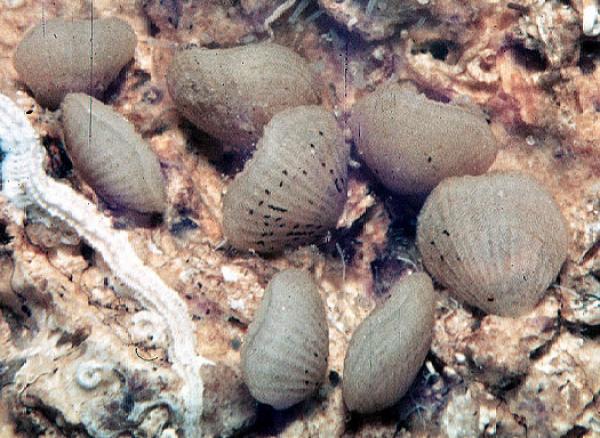Brachiopods (Brachiopoda)
Brachiopods are a phylum of marine animals that have hard "valves" (shells) on the upper and lower surfaces. Most species of brachiopod went extinct during the P–T extinction over 250 million years ago, but many survive today.
Brachiopod valves are hinged at the rear end, while the front can be opened for feeding or closed for protection. Articulate brachiopods have toothed hinges and simple opening and closing muscles, while inarticulate brachiopods have untoothed hinges and more complex muscles. In a typical brachiopod a stalk-like pedicle projects from an opening in the hinge or from a hole in the larger valve, attaching the animal to the sea bed but clear of silt that would obstruct the opening.
Brachiopods have a mantle that secretes and lines the shell, and encloses the internal organs. The body occupies typically about one-third of the internal space inside the shell, nearest the hinge. The rest of the mantle encloses a water-filled space containing the lophophore, a crown of tentacles that filters food particles out of the water. In all species the lophophore is supported by cartilage and by a hydrostatic skeleton.
The lophophore filters food, mostly phytoplankton, out of the water. From there the food is transported in succession to: the grooves along the bases of the lophophore's tentacles; the mouth; pharynx; oesophagus; and finally the stomach, where the food is digested. Nutrients are transported from the stomach throughout the coelom (main body cavity), including the mantle lobes, by cilia. The wastes produced by metabolism are broken into ammonia, which is eliminated by diffusion through the mantle and lophophore.
The lophophore and mantle are the only surfaces that absorb oxygen and eliminate carbon dioxide. Oxygen seems to be distributed by the fluid of the coelom. The heart is above the stomach, and the blood vessels connect it to the major organs. However, the main function of the blood may be to deliver nutrients. The maximum oxygen consumption of brachiopods is low, and their minimum requirement is not measurable.
Lifespans range from 3 to over 30 years. Ripe gametes (ova or sperm) float from the gonads into the main coelom and then exit into the mantle cavity. The larvae of inarticulate brachiopods are miniature adults, with lophophores that enable the larvae to feed and swim for months, until the animals become heavy enough to settle to the seabed. Larvae of articulate species are different from the adult forms, live only on yolk, and remain among the plankton for only a few days before metamorphosing. The traditional classification into inarticulate and articulate brachiopods has been supplemented by two refinements that appeared in the 1990s. One refinement groups the inarticulate Craniida with articulate brachiopods, as both used the same material in the mineral layers of the shell. The other segregates the Craniida into a third group, as their outer organic layer is different from that of either the others. However, some taxonomists believe it is premature to define the higher levels of classification such as order, and recommend instead a bottom-up approach that identifies genera and then groups these into intermediate groups. Traditionally brachiopods have been regarded as members of or as a sister group to the deuterostomes, a super-phylum which includes chordates and echinoderms. One type of analysis of brachiopods' evolutionary relationships has always placed brachiopods as protostomes, while another type has split between placing brachiopods among the protostomes or the deuterostomes.
| ||
Virtual museum of the Czech Geological Survey, www.geology.cz, (C) Czech Geological Survey, 2011, v.0.99 [13.12.2011]


![[ENG]](img/vlajka-cr.gif) Česky
Česky 
